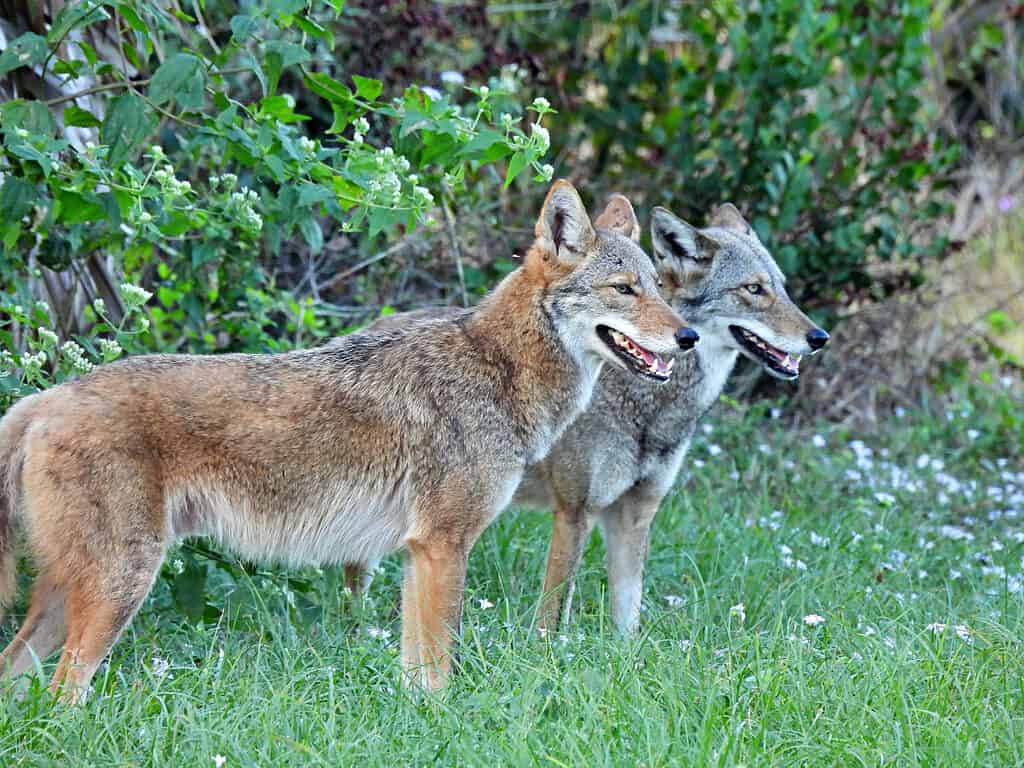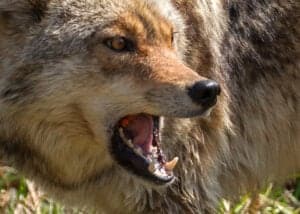South Carolina offers a warm and inviting place for locals and tourists alike to relax. With warm beaches, festivals, and many golf courses, the last thing that anyone wants to think about is coyotes. However, the abundant coyotes in South Carolina can’t be ignored. Reaching at least 35 pounds as an adult, these hungry forages spread disease and destroyed the local white-tailed deer population. While they are easy to mistake for a dog from far away, their long muzzle and bushy fur are signs that they aren’t friendly strays.
While there are efforts in place to control the population, you can’t freely hunt coyotes. Instead, local legislation imposed important limits on hunting them. By keeping the community safe and keeping the population under control, South Carolina continues to prioritize families and their protection from dangerous wildlife. Here’s what you need to know about South Carolina’s coyotes.
Current Coyote Population In South Carolina

To maintain control of the population, approximately 30,000 coyotes are hunted each year, but their numbers continue to thrive in every county.
©iStock.com/passion4nature
While some rumors suggest that South Carolina’s local government brought over the coyotes to control the white-tailed deer population, it is nothing more than a myth. the South Carolina Department of Natural Resources maintains that they are not responsible for the growing population. However, coyotes don’t naturally thrive in South Carolina, so how are they thriving so well?
Seen in every county in South Carolina, the original culprits of the coyote population used them for hound running in the 1970s. Hound running is currently illegal, which is why federal government officials continue to watch for these imports. Once the coyotes started reproducing in the wild, they started migrating east, spreading their coverage over the state. They can live almost everywhere, ranging from rural agricultural areas to swamps. They even thrive in suburban areas, seeing out prey that is much smaller than them, which is dangerous for any outdoor pets.
Where Are Coyotes Abundant In South Carolina?
Unfortunately, coyotes seem to adapt to wherever they are. At one time, researchers thought that these predators preferred to live in dry and grassy areas, but they would go anywhere that had abundant food. As the population grows, researchers find that the deer and small game populations start to dwindle. The efforts of local hunters help to keep game like turkeys and deer in abundant and healthy numbers. Since coyotes can produce up to 7 pups in a single litter, every winter is an opportunity to grow the population.
Nowadays, the range that coyotes are comfortable to hunt and breed has expanded. When they aren’t able to get their main prey from local forests, these fearless animals venture into cities and suburban areas to try to satisfy their hunger. They sometimes go into yards, attracted to the smell of outdoor domestic pets that might make a good meal for them.
These coyotes generally don’t get close to humans unless necessary, which may mean that they are hungry or thirsty. If you take care of chickens or rabbits, you might need to bring them inside or call a local predator removal service.
Typical Diet Of Coyotes

Coyotes will go after any small game that they can catch, and that may even involve livestock in rural areas.
©FRAYN/Shutterstock.com
If you want to keep coyotes away from your home, you cannot leave anything that they will eat. Acting opportunistically, coyotes eat whatever prey is available to survive. They are omnivores, so they will just as quickly eat fruits and berries as they hunt rabbits, insects, and deer. Coyotes tend to be territorial, and they don’t have any other animals to hunt when they reach suburban areas.
How Does The Coyote Population Affect South Carolina?
Over the last 50 years, coyotes have caused much damage in South Carolina. As a major predator of the white-tailed deer – South Carolina’s state animals – it primarily goes after defenseless fawns when they are at their most vulnerable. Local hunters can’t collect what they need during hunting season without allowing fawns to make it to adulthood. In the last 20 years, the predatory nature of coyotes has cost the state 30% of its deer population. Since implementing the Coyoted Harvest Incentive Program, the population has sustained nearly a 40% drop in the last 10 years.
Rules And Regulations For Hunting Coyotes In South Carolina

Anyone who wants to hunt coyotes in South Carolina will need to follow the local regulations.
©fusaromike/iStock via Getty Images
Here are the rules to follow when hunting coyotes in South Carolina.
- Do not hunt for coyotes on private land.
- If you encounter a coyote within 100 yards of your home, you do not need a hunting license to shoot it.
- You can only participate in night hunting if the property is registered for it.
- Trapping season starts in December and ends on the first day of March.
- If you trap a coyote, you cannot relocate it.
- It is illegal to use poison to kill coyotes or any other wildlife in the United States.
Local legislation allowed the formation of the Coyote Harvest Incentive Program to control the population. The program involves a tag-and-release incentive, providing a $3,000 reward from the Department of Natural Resources with every tagged coyote. Hunters can designate the reward for anyone, but they can’t collect it more than twice a year.
The photo featured at the top of this post is © graphicphoto/iStock via Getty Images
Thank you for reading! Have some feedback for us? Contact the AZ Animals editorial team.





